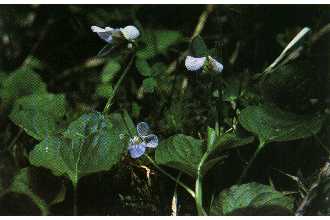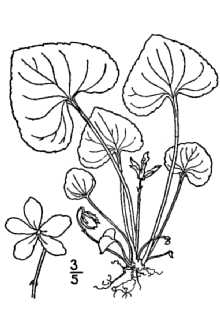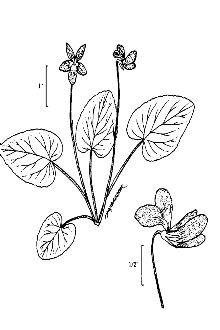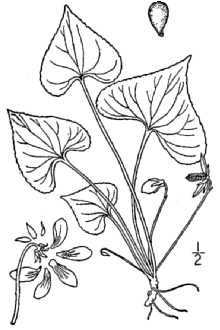Viola retusa Greene
Scientific Name: Viola retusa Greene

| General Information | |
|---|---|
| Usda Symbol | VIRE9 |
| Group | Dicot |
| Life Cycle | AnnualPerennial, |
| Growth Habits | Forb/herb |
| Native Locations | VIRE9 |
Plant Guide
Description
General: Northern bog violet plants are 1.6 to 4 inches (4 to 10 cm) tall with 0.4 to 0.8 inch (10 to 20 mm) purple or blueish flowers with a notable 0.1 to 0.2 inch (2 to 5 mm) long spur in the posterior (Figure 1). Its Latin epithet comes from the rounded kidney-shaped leaves with cordate bases. Some sources note the presence of thickened rhizomes (Hitchcock and Cronquist, 1961; Welsh et al., 2003), while others indicate plants arising from a stout vertical rootstock (Davis, 1952; Goodrich and Huber, 2014). Distribution: Northern bog violet is a widespread native forb, occurring throughout North America with the exception of the southeastern states. For current distribution, please consult the Plant Profile page for this species on the PLANTS Web site. Habitat: Northern bog violet can be found in bogs, marshes, seeps, moist meadows and streambanks throughout a broad elevational range and can be found in all plant communities from desert scrub to alpine forests so long as localized moist conditions exist (Kearney and Peebles, 1951; Welsh et al., 2003).
Adaptation
This species is adapted to regularly damp soil conditions including seeps, springs and wetlands. It can also be found in shady woodland environments where soil moisture is high.
Uses
Northern bog violet is a host plant for various fritillary butterflies, including the Nokomis fritillary (Speyeria nokomis) caterpillars (Scott, 1986).
Status
Threatened or Endangered: Northern bog violet is listed as a species of special concern in Connecticut, It is classified as endangered in the states of Massachusetts, New York and Ohio and Threatened in New Hampshire (USDA, 2021), Wetland Indicator: Northern bog violet is classified as a facilitative wetland (FACW) species in the Arid West, Atlantic and Gulf Coastal Plain, Eastern Mountains and Piedmont, Great Plains, Midwest, Northcentral and Northeast, and Western Mountains, Valleys and Coast regions (USDA, 2021), Please consult the PLANTS Web site (http://plants, Use soil moisture sensors to measure the soil moisture of Viola retusa Greene.,usda,gov/) and your state’s Department of Natural Resources for this plant’s current status (e,g,, threatened or endangered species, state noxious status, and wetland indicator values),
Planting Guidelines
Seed should be sown in the fall or be pre-stratified before sowing (see below) to a depth of 0- ¼ inch. There are approximately 497,000 seeds/lb (Tilley et al., 2021). Recommended full stand seeding rate is approximately 4-5 lb/ac for Natural Resources Conservation Service Plant Guide Figure 1. Northern bog violet is a small perennial forb with spurred purple flowers. Photo by Derek Tilley.
Management
Wetlands, seeps, springs, and other moist habitats in the arid west where northern bog violet is likely to be found are sensitive environments and thus should be protected from activities such as grazing, recreational vehicle use, and deforestation.
Pests and Potential Problems
No pests or potential problems are known.
Environmental Concerns
Concerns
Concerns
None.
Seeds and Plant Production
Plant Production
Plant Production
Pollination in the Violaceae is rather unique. Perfect flowers in the genus Viola are formed in the spring, specially evolved for insect pollination. One petal is large and spurred with nectar guides to draw insects (typically bees) under the pollen-bearing anthers above (Zomlefer, 1994). However, later in the season, in response to lengthening photoperiods, the plants produce cleistogamous flowers in which self-fertilization occurs within permanently closed petals (Russell, 1960). Plants produce fruit and seed via cleistogamy in late summer. The capsules will lose their green color and the pedicels will elevate the capsule above the leaves (Figure 2). These capsules can be hand harvested daily to maximize seed yields. The capsules should be placed in a paper sack at room temperature for drying. Violet capsules are explosively dehiscent, so the bag should be kept closed (but not airtight) to prevent seed from shooting out of the bag. After drying, dried stems and capsule pieces can be sieved by hand with a 2.1 mm wire mesh screen, and dust removed using a 710 µm screen. Immature and unfilled seed can be removed by running the seed over an air column set on a very low setting. Collection from 50 plants from July 1 through October 1 (92d) resulted in approximately 10,000 seeds (Tilley et al., 2021). Despite being described by some in the taxonomic literature as having stout elongated rhizomes (Hitchcock and Cronquist, 1961; Welsh et al., 2003), Tilley et al. (2021) saw no evidence of rhizomes on any plants dug from native stands in northeast Utah or on greenhouse produced plants. The root systems were described as very fibrous. Asexual division was unsuccessful (Tilley et al., 2021). Propagation protocols for other North American native members of the violet genus typically involve a 90 to 120 day cold-moist stratification period to break seed dormancy (Schultz et al., 2002; Bartow, 2015). Tilley et al. (2021) tested three durations of stratification (30d, 60d and 90d) with and without the addition of an oxygenated water bath. They found maximum germination was achieved by stratifying the seed for 60d of cold-moist stratification without the aid of oxygenation. Increasing stratification to 90d did not further increase germination percentage. Cultivars, Improved, and Selected Materials (and area of origin) There are no cultivars or improved materials of northern bog violet available from commercial sources. Wildland or Variety Not Stated (VNS) seed may be available.
Literature Cited
Bartow A. 2015. Propagation protocol for production of Container (plug) Viola adunca plants USDA NRCS - Corvallis Plant Materials Center Corvallis, Oregon. In: Native Plant Network. URL: http://NativePlantNetwork.org (accessed 10 September 2020). US Department of Agriculture, Forest Service, National Center for Reforestation, Nurseries, and Genetic Resources. Davis RJ. 1952. Flora of Idaho. Brigham Young University Press. Provo (UT). 836 p. Goodrich S, Huber H. 2014. Uinta Flora. U.S. Department of Agriculture Forest Service-Intermountain Region. Ogden (UT). 314 p. Figure 2. In response to lengthening photo periods, northern bog violet produces fruit asexually (above). Capsules dry and release seed explosively (below). Photos by Derek Tilley. Hitchcock CL, Cronquist A. 1961. Vascular Plants of the Pacific Northwest. Part 3: Saxifragaceae to Ericaceae. University of Washington Press. Seattle (WA). 614 p. Kearney TH, Peebles RH. 1951. Arizona Flora. University of California Press, Berkeley and Los Angeles (CA). 1032 p. Russell NH. 1960. Studies in the photoperiodic responses of violets (Viola). South W. Naturalist 5:177-186. Schultz J, Beyer P, Williams J. 2002. Propagation protocol for production of Container (plug) Viola canadensis L. plants USDA FS - Hiawatha National Forest Marquette, Michigan. In: Native Plant Network. URL: http://NativePlantNetwork.org (accessed 10 September 2020). US Department of Agriculture, Forest Service, National Center for Reforestation, Nurseries, and Genetic Resources. Scott JA. 1986. The butterflies of North America. Stanford University Press, Stanford (CA). 583p. Tilley D, Wolf M, Spencer J. 2021. Seed Production and Propagation of Northern Bog Violet (Viola nephrhophylla) for Nokomis Fritillary (Speyeria nokomis) Butterfly Habitat Restoration. 10 p. [USDA NRCS] USDA Natural Resources Conservation Service. 2020. The PLANTS Database. URL: http://plants.usda.gov (accessed 9 September 2020) Greensboro (NC): National Plant Data Team Welsh SL, Atwood ND, Goodrich S, Higgins LC. 2003. A Utah Flora. Third Edition, revised. Brigham Young University, Provo (UT). 912 p. Zomlefer WB. 1994. Guide to flowering plant families. The University of North Carolina Press. Chapel Hill (NC). 430 p. Citation Tilley, D., Spencer, J., and M. Wolf. 2021. Plant Guide for northern bog violet (Viola nephrophylla). USDA-Natural Resources Conservation Service, Aberdeen Plant Materials Center. Aberdeen, ID. Published April 2021 Edited: For more information about this and other plants, please contact your local NRCS field office or Conservation District at http://www.nrcs.usda.gov/ and visit the PLANTS Web site at http://plants.usda.gov/ or the Plant Materials Program web site: http://plant-materials.nrcs.usda.gov. PLANTS is not responsible for the content or availability of other Web sites. In accordance with Federal civil rights law and U.S. Department of Agriculture (USDA) civil rights regulations and policies, the USDA, its Agencies, offices, and employees, and institutions participating in or administering USDA programs are prohibited from discriminating based on race, color, national origin, religion, sex, gender identity (including gender expression), sexual orientation, disability, age, marital status, family/parental status, income derived from a public assistance program, political beliefs, or reprisal or retaliation for prior civil rights activity, in any program or activity conducted or funded by USDA (not all bases apply to all programs). Remedies and complaint filing deadlines vary by program or incident. Persons with disabilities who require alternative means of communication for program information (e.g., Braille, large print, audiotape, American Sign Language, etc.) should contact the responsible Agency or USDA's TARGET Center at (202) 720-2600 (voice and TTY) or contact USDA through the Federal Relay Service at (800) 877-8339. Additionally, program information may be made available in languages other than English. To file a program discrimination complaint, complete the USDA Program Discrimination Complaint Form, AD-3027, found online at How to File a Program Discrimination Complaint and at any USDA office or write a letter addressed to USDA and provide in the letter all of the information requested in the form. To request a copy of the complaint form, call (866) 632-9992. Submit your completed form or letter to USDA by: (1) mail: U.S. Department of Agriculture, Office of the Assistant Secretary for Civil Rights, 1400 Independence Avenue, SW, Washington, D.C. 20250-9410; (2) fax: (202) 690-7442; or (3) email: program.intake@usda.gov. USDA is an equal opportunity provider, employer, and lender.



